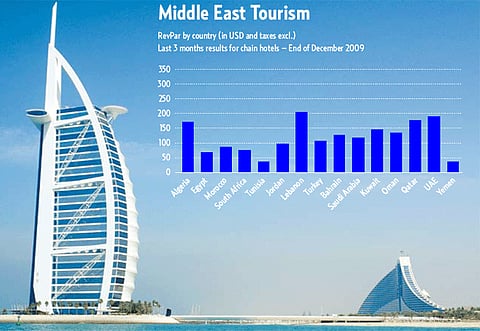Mena hotels enjoy 4.6% increase in occupancy rates
Report signals recovery on its way while airlines expect better profits

Dubai: Hotels throughout the Middle East and North Africa (Mena) showed modest signs of recovery towards the end of 2009 with occupancy rates improving by 4.6 per cent, according to a recent MKG Hospitality report.
"There is a clear sign that hotels are entering the next stage of the cycle and that a slow recovery is on the way. At the moment, rates are reflecting the state of the economy and in particular, a drop in purchasing power. Once the economy picks up and hotel occupancy begins increasing, hoteliers will be able to slowly balance and then raise average rates in turn boosting overall revenue per room (RevPAR) results," Vanguelis Panayotis, director of development, MKG Hospitality, said in a statement.
This improved occupancy is helped by the fact that according to the International Air Transport Association, 76 per cent of world airlines expect profitability to improve over the next 12 months. The Middle Eastern carriers in particular are expecting to see losses shrink to $300 million (Dh1.1 billion) in 2010 from a $1.2 billion in 2009.
New aircraft
Airlines are expected to buy up to 870 aircraft by 2027, improving accessibility to the region. In the last three months heavy price cuts have continued throughout the region, in an attempt to stimulate or maintain demand. Room rates in the UAE fell to 2007 levels to encourage visitors.
"The UAE has done very well in adapting to the international market's changing rates. There were a lot of comments about Dubai being expensive so we've adapted to make it very affordable to tourists," Gassan Aridi, CEO of Alpha Tours, told Gulf News by telephone.
The UAE recorded a 20.8 per cent RevPAR decline in 2009, mainly driven by an average daily rate drop of 15.2 per cent.
This has been a large turnaround since 2008 when average room rates increased by 16.5 per cent over 2007.
"Various recent events such as Arabian Health 2010 and the Dubai Shopping Festival have certainly helped to improve the occupancy levels. The good currency exchange and cold weather in Europe are also encouraging tourists to come here for the warmer climate," says Aridi.
Dubai recorded the largest RevPAR fall in 2009, down 27.5 per cent, while Abu Dhabi had steadier rates, down only 4.9 per cent.
"Abu Dhabi has adopted a much more consolidated approach towards developments, no doubt allowing the emirate to sustain healthier results [namely a lower decline] during this difficult period. As the global economy improves, more likely towards the end of 2010 and into 2011, the UAE capital should see very good growth," said Panayotis.
Frederic Bardin, senior vice president of Arabian Adventures, told Gulf News in an interview one of the things that need to go in tandem with the new tourist attractions being developed in Dubai is budget accommodation in the form of two-star or three-star hotels. "There are more three-star hotels being built, but we're still lacking in two-star hotels. You can only have so many five-star hotels."
Along with improving the numbers, Bardin says the standards also need to be enhanced. "[The] two-star hotel market in Dubai is substandard and does not appeal to the European and American market."
According to the World Travel and Tourism Council, annual travel and tourism revenues in the region are expected to rise 89 per cent over the next ten years and will be worth Dh1,025 billion by 2016.
Sign up for the Daily Briefing
Get the latest news and updates straight to your inbox



